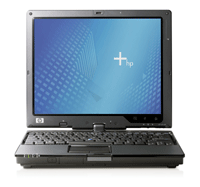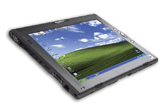At Comdex 2001, Microsoft chairman Bill Gates predicted that by 2005, tablet PCs would be so popular they would outstrip notebook sales and possibly even compete with desktops. Today, however, it really is 2005, and some companies are backing away from tablet PCs altogether. ViewSonic, for example, no longer makes tablets, not that they rated well in past GCN Lab tests. Most vendors are hedging their bets by building convertible notebooks that turn into tablets when you fold the screen back over the keyboard.Unfortunately, the first tablets came out before their time. They launched before the mobile chip sets required to power them came of age, before tablet-specific operating systems arrived and before low-voltage processors could help improve form factors and boost battery life. They suffered something of a backlash that has stuck.Still, tablet PCs in one form or other are perfect systems for a lot of government workers, and the technology has advanced dramatically. You now can get a large screen you interact with using a pen instead of a bulky mouse or keyboard, battery life comparable to or better than a notebook's, and enough performance to drive most applications. The Joint Futures Laboratory, for instance, deploys hundreds of tablet PCs to its employees, whose job it is to experiment with new technologies in support of the Joint Forces Command.The GCN Lab rounded up five tablets'four convertibles and one traditional slate'to see if these systems have continued to improve.The systems we tested'the Acer TravelMate C314XMi, Fujitsu Lifebook T4000, Hewlett-Packard tc4200, Motion LE 1600 and Toshiba Tecra M4-S435'offer a variety of choices to government buyers. The Motion LE 1600 is the only pure tablet in the review, and we liked it enough to recommend it although it doesn't offer the same performance as the convertibles (nor should it).The four convertibles fell into two camps. The HP tc4200 and LifeBook T4000 are lightweight systems with decent batteries'important if you plan to use them like a true tablet. But they don't have the quite the performance of the TravelMate C314XMi and Tecra M4-S435.That said, the TravelMate and Tecra systems are more notebook than tablet ' good performance but poor battery life. Deciding how much you plan to use the tablet features is important in making a buying decision.In the end, we recommend the LE 1600 as a pure tablet and the HP tc4200 as a convertible. Depending on your needs, both offer good tablet functionality Good processor performance Short battery life, heavy B A B+ B- B+The TravelMate C314XMi is a high-performance notebook that may actually be too heavy for a tablet. With a 14.1-inch screen, you have plenty of room to let tablet applications like Microsoft's OneNote spread out, which is nice. Our model came with a 90G hard drive (partitioned into two drives) and WiFi radio. And the 2GHz processor and 1G of memory meant even applications that use video and audio responded quickly during testing. In fact, the TravelMate C314XMi scored 7,987 on the GCN benchmarks, which is good for a notebook and even beats quite a few desktops.The bad news is that this convertible notebook weighs 6.4 pounds'a lot for a portable and the most of any system in this review. The heaviest notebook we've ever used on the road was eight pounds, and it was a real albatross to lug around airports and train stations. Because users often want to hold tablets in one hand and jot on them with the other, their weight is a much bigger factor than it is for a notebook you can rest in your lap.Battery life isn't especially great, either'another significant knock if you intend to use the tablet functionality often. The TravelMate lasted just one hour and 47 minutes on our benchmark tests, which admittedly test notebooks under worst-case circumstances but accurately reflects their energy efficiency versus similar models, such as the HP tc4200 convertible (two hours, 44 minutes).The TravelMate is far more notebook than it is tablet. If you only plan to jot notes occasionally, the system's performance, features and attractive $1,999 price tag make it worth considering. But if you expect to be using the tablet features frequently, there are better choices.Acer Inc., San Jose, Calif., 800-733-2737, Good balance of features, light Beaten in most areas by others in this review B B B B+ BThe Lifebook T4000 is a perfect middle-of-the-road convertible notebook. It is not a big, powerful system that's too heavy to use and short of battery life. But it isn't underpowered, either.[IMGCAP(3)]The 4.3-pound LifeBook T4000 is the lightest of the convertible notebooks we tested. The 12.1-inch screen is crisp and easy to read, and we found the system easy to use and quick to respond to pen commands in tablet mode.The LifeBook T4000, with its 1.8GHz Intel processor, scored 6,119 on the GCN Alterion benchmark tests, meaning it can handle your applications well (and certainly better than a straight tablet PC), but other systems in this review performed better.The battery lasted for two hours and 21 minutes, which is also respectable'in this case, better than the high-performing convertibles but not as good as a straight tablet (see the Motion LE 1600 below).If you are not sure whether you will be using your system more as a notebook or a tablet, the T4000 is a good way to hedge your bet. Other systems here beat it in areas like raw performance or battery life, but the T4000 turns in reliable performance adequate for any situation.Fujitsu Computer Systems Corp., Santa Clara, Calif., 800-538-8460, Best mix of notebook and tablet Pricey A- A- A- A- B-The tc4200 is one of the best examples of a convertible tablet notebook. Its 12.1-inch screen is a good size for a laptop and works well when converted into tablet mode. As a straight notebook with a 2GHz Pentium M pro- cessor and 1G of memory, it's not among the fastest we've tested, but with a GCN Alterion benchmark score of 6,608, we're sure it can easily handle most mobile applications.Our test unit was configured with a 55G hard drive and a 2X DVD+/-RW drive, which could also burn normal CDs. The drive is slim at only 9.5 mm. We didn't even notice it before seeing it listed on the product specs. In fact, the entire unit measures only 1.1 by 11.2 by 9.2 inches and weighs just 4.6 pounds'a compact package we found easy to maneuver and work with.The tc4200 ran almost three hours with the bundled WiFi radio active and a movie constantly running'the best battery life of the convertibles we tested and admirable for any notebook running on its standard battery. You can buy a larger, eight-cell battery for $129.Compared to other tablets in this review, the $2,327 tc4200 is a bit pricey, but if you want a tablet computer and don't feel comfortable abandoning your keyboard altogether just yet, it's a good choice, hitting the sweet spot between a notebook and a tablet.Hewlett-Packard Co., Palo Alto, Calif., 800-888-9909, Light, good battery life Underpowered, expensive B+ B- A- A [IMGCAP(2)]Motion Computing is one of the few companies that have never backed away from the slate form factor for its tablets, which is how tablets were originally designed. While other companies have left the market or moved to convertible models, Motion has stuck with the original plan and the new LE 1600 is part of that plan. There's no keyboard here. The LE 1600 is all tablet. And if that's what you're looking for, you won't be disappointed.Still, it would seem the LE 1600 is outclassed, given that it scored 3,000 points lower than most others on the application-based GCN/Alterion benchmarks. However, its performance is adequate for most applications the tablet is likely to run into, such as basic productivity and input/output programs. It may take a little while to open Photoshop files, but you could if you wanted'the LE 1600 runs the same Windows XP Tablet PC Edition as others in this review. It just happens to come with a slower processor (1.5GHz) than the others do.But that Intel 1.5GHz Pentium M processor is one of the low-voltage chips, so the LE 1600 is built for mobility. In our battery testing, in which we run a movie with the screen fully bright and no power-saving features active, it lasted four hours and 13 minutes, which means it could probably last all day with normal use.Keep in mind that the LE 1600 came to us with an optional, $229 extended battery that doubled its capacity and brought the total price tag to $2,498. Normally, our review would have been more skeptical (and the cost-conscious should keep in mind you need to pay more to get an LE 1600 that runs for several hours), but we were impressed that even with the extra battery, the unit weighed only 3.3 pounds. Granted, there's no keyboard, and the unit is supposed to weigh less than convertibles, but even outfitted for maximum battery life, the LE 1600 is incredibly easy to use and carry.And it's not like this is a PDA. The LE 1600 comes with 512M of memory, a 55G hard drive, WiFi and an integrated Intel graphics chip just like many notebooks. There are still many specialized government users who need a lightweight slate tablet without giving up many standard PC features. For those folks, we can recommend the LE 1600.Motion Computing Inc., Austin, Texas, 866-682-2538, Excellent performance, big screen Poor battery life, heavy B- A- B C+ B+The Tecra M4-S435 looks like a desktop replacement notebook and performs al-most like one, too, scoring 7,272 on our benchmark tests. It has a huge 14.1-inch screen, which is perfect for tablet-type applications. To convert it, you simply turn the screen around and fold it over the keyboard. A small plastic latch locks it down in tablet configuration, a nice touch that keeps the lower half of the unit from separating when you are carrying it around. And it only takes one button to release the latch, so the notebook/tablet meets 508 disability requirements.But who wants to carry around a desktop replacement in one hand to jot on it with the other? The Tecra M4-S435 is only marginally suitable as a tablet PC. The biggest problem is that it weighs 6.2 pounds, which is heavy for lugging around all day. Plus, the system's battery life is relatively poor. At one hour and 25 minutes, it performed the worst of the tablets we tested.As a straight notebook, the Tec- ra M4-S435 is ac- tually quite nice, with its 1.73GHz processor, 512M of memory and spacious 70G hard drive. It also comes with built-in WiFi and a Trusted Computing Platform module. And at $1999, it's fairly affordable. Like the Acer TravelMate C314XMi, the Tecra M4-S435 would make a good option for users who only occasionally need to use a tablet. It's a notebook first and a tablet a distant second.Toshiba America Information Systems Inc., Irvine, Calif., 949-583-3000,
The Hewlett-Packard tc4200 is a perfect blend of notebook and tablet.
Many users need a lightweight, tablet-only system. The Motion LE 1600 fits the bill nicely.









